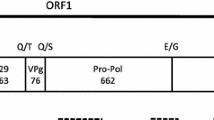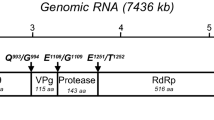Abstract
We describe the identification and genetic characterization of a novel enteric calicivirus, detected by transmission electron microscopy and RT-PCR in two clinically normal chickens and in a chicken with runting and stunting syndrome from different flocks in southern Germany. Positive findings were confirmed by sequencing. The complete nucleotide sequence and genome organization of one strain (Bavaria/04V0021) was determined. The genome of the Bavaria virus is 7,908 nt long and contains two coding open reading frames. Phylogenetic analysis of the deduced partial 2C helicase/NTPase, 3C cysteine protease, RNA-dependent RNA polymerase and complete VP1 capsid protein amino acid sequences showed that the virus is genetically related to but distinct from sapoviruses and lagoviruses. Morphologically, the Bavaria virus particles are 37-42 nm in diameter and exhibit characteristic cup-shaped surface depressions.


Similar content being viewed by others
References
Carstens EB (2010) Ratification vote on taxonomic proposals to the International Committee on Taxonomy of Viruses (2009). Arch Virol 155:133–146
Green KY, Ando T, Balayan MS, Berke T, Clarke IN, Estes MK, Matson DO, Nakata S, Neill JD, Studdert MJ, Thiel HJ (2000) Taxonomy of the caliciviruses. J Infect Dis 181(Suppl 2):S322–S330
Farkas T, Sestak K, Wei C, Jiang X (2008) Characterization of a rhesus monkey calicivirus representing a new genus of Caliciviridae. J Virol 82:5408–5416
L’Homme Y, Sansregret R, Plante-Fortier E, Lamontagne AM, Ouardani M, Lacroix G, Simard C (2009) Genomic characterization of swine caliciviruses representing a new genus of Caliciviridae. Virus Genes 39:66–75
Reuter G, Zimsek-Mijovski J, Poljsak-Prijatelj M, Di Bartolo I, Ruggeri FM, Kantala T, Maunula L, Kiss I, Kecskemeti S, Halaihel N et al (2010) Incidence, diversity, and molecular epidemiology of sapoviruses in swine across Europe. J Clin Microbiol 48:363–368
Wolf S, Williamson W, Hewitt J, Lin S, Rivera-Aban M, Ball A, Scholes P, Savill M, Greening GE (2009) Molecular detection of norovirus in sheep and pigs in New Zealand farms. Vet Microbiol 133:184–189
Reuter G, Pankovics P, Egyed L (2009) Detection of genotype 1 and 2 bovine noroviruses in Hungary. Vet Rec 165:537–538
Scipioni A, Mauroy A, Vinje J, Thiry E (2008) Animal noroviruses. Vet J 178:32–45
Koopmans M (2008) Progress in understanding norovirus epidemiology. Curr Opin Infect Dis 21:544–552
Smith AW, Skilling DE, Cherry N, Mead JH, Matson DO (1998) Calicivirus emergence from ocean reservoirs: zoonotic and interspecies movements. Emerg Infect Dis 4:13–20
Guo M, Evermann JF, Saif LJ (2001) Detection and molecular characterization of cultivable caliciviruses from clinically normal mink and enteric caliciviruses associated with diarrhea in mink. Arch Virol 146:479–493
Poet SE, Skilling DE, Megyesl JL, Gilmartin WG, Smith AW (1996) Detection of a non-cultivatable calicivirus from the white tern (Gygis alba rothschildi). J Wildl Dis 32:461–467
Sironi G (1994) Concurrent calicivirus and Isospora lacazei infections in goldfinches (Carduelis carduelis). Vet Rec 134:196
Cubitt WD, Barrett AD (1985) Propagation and preliminary characterization of a chicken candidate calicivirus. J Gen Virol 66(Pt 7):1431–1438
Wyeth JP, Chettle NJ, Labram J (1981) Avian calicivirus. Vet Rec 109:477
Gough RE, Drury SE, Bygrave AC, Mechie SC (1992) Detection of caliciviruses from pheasants with enteritis. Vet Rec 131:290–291
Toffam A, Bano L, Montesi F, Beato MS, De Nardi R, Terregino C, Capua I (2005) Detection of Caliciviruses in young pheasants (Phasianus colchicus) with enteritis in Italy. Ital J Anim Sci 4:300–302
Gough RE, Spackman D (1981) Virus-like particles associated with disease in guinea fowl. Vet Rec 109:497
Morrow CJ, Samu G, Matrai E, Klausz A, Wood AM, Richter S, Jaskulska B, Hess M (2008) Avian hepatitis E virus infection and possible associated clinical disease in broiler breeder flocks in Hungary. Avian Pathol 37:527–535
Tamura K, Dudley J, Nei M, Kumar S (2007) MEGA4: molecular evolutionary genetics analysis (MEGA) software version 4.0. Mol Biol Evol 24:1596–1599
Meyers G, Wirblich C, Thiel HJ, Thumfart JO (2000) Rabbit hemorrhagic disease virus: genome organization and polyprotein processing of a calicivirus studied after transient expression of cDNA constructs. Virology 276:349–363
Strive T, Wright JD, Robinson AJ (2009) Identification and partial characterisation of a new Lagovirus in Australian wild rabbits. Virology 384:97–105
Guo M, Chang KO, Hardy ME, Zhang Q, Parwani AV, Saif LJ (1999) Molecular characterization of a porcine enteric calicivirus genetically related to Sapporo-like human caliciviruses. J Virol 73:9625–9631
Jeong C, Park SI, Park SH, Kim HH, Park SJ, Jeong JH, Choy HE, Saif LJ, Kim SK, Kang MI et al (2007) Genetic diversity of porcine sapoviruses. Vet Microbiol 122:246–257
Green KY, Chanock RM, Kapikian AZ (2001) Human calicivirus. In Knipe HP (ed) Fields virology, vol 1, 4th edn. Lippincott Williams & Wilkins, Philadelphia, pp 841–874
Hansman GS, Oka T, Katayama K, Takeda N (2007) Human sapoviruses: genetic diversity, recombination, and classification. Rev Med Virol 17:133–141
McIntosh MT, Behan SC, Mohamed FM, Lu Z, Moran KE, Burrage TG, Neilan JG, Ward GB, Botti G, Capucci L, Metwally SA (2007) A pandemic strain of calicivirus threatens rabbit industries in the Americas. Virol J 4:96
Pesavento PA, Chang KO, Parker JS (2008) Molecular virology of feline calicivirus. Vet Clin North Am Small Anim Pract 38:775–786, vii
Kurth A, Evermann JF, Skilling DE, Matson DO, Smith AW (2006) Prevalence of vesivirus in a laboratory-based set of serum samples obtained from dairy and beef cattle. Am J Vet Res 67:114–119
Edwards JF, Yedloutschnig RJ, Dardiri AH, Callis JJ (1987) Vesicular exanthema of swine virus: isolation and serotyping of field samples. Can J Vet Res 51:358–362
Martella V, Campolo M, Lorusso E, Cavicchio P, Camero M, Bellacicco AL, Decaro N, Elia G, Greco G, Corrente M et al (2007) Norovirus in captive lion cub (Panthera leo). Emerg Infect Dis 13:1071–1073
Martella V, Lorusso E, Decaro N, Elia G, Radogna A, D’Abramo M, Desario C, Cavalli A, Corrente M, Camero M et al (2008) Detection and molecular characterization of a canine norovirus. Emerg Infect Dis 14:1306–1308
Neill JD, Meyer RF, Seal BS (1995) Genetic relatedness of the caliciviruses: San Miguel sea lion and vesicular exanthema of swine viruses constitute a single genotype within the Caliciviridae. J Virol 69:4484–4488
Seal BS, Lutze-Wallace C, Kreutz LC, Sapp T, Dulac GC, Neill JD (1995) Isolation of caliciviruses from skunks that are antigenically and genotypically related to San Miguel sea lion virus. Virus Res 37:1–12
van der Poel WH, van der Heide R, Verschoor F, Gelderblom H, Vinje J, Koopmans MP (2003) Epidemiology of Norwalk-like virus infections in cattle in The Netherlands. Vet Microbiol 92:297–309
Wang QH, Costantini V, Saif LJ (2007) Porcine enteric caliciviruses: genetic and antigenic relatedness to human caliciviruses, diagnosis and epidemiology. Vaccine 25:5453–5466
Karst SM, Wobus CE, Lay M, Davidson J (2003) Virgin HWt: STAT1-dependent innate immunity to a Norwalk-like virus. Science 299:1575–1578
Radford AD, Coyne KP, Dawson S, Porter CJ, Gaskell RM (2007) Feline calicivirus. Vet Res 38:319–335
Hurley KF, Sykes JE (2003) Update on feline calicivirus: new trends. Vet Clin North Am Small Anim Pract 33:759–772
Cooke BD (2002) Rabbit haemorrhagic disease: field epidemiology and the management of wild rabbit populations. Rev Sci Tech 21:347–358
van Der Poel WH, Vinje J, van Der Heide R, Herrera MI, Vivo A, Koopmans MP (2000) Norwalk-like calicivirus genes in farm animals. Emerg Infect Dis 6:36–41
Vinje J, Altena SA, Koopmans MP (1997) The incidence and genetic variability of small round-structured viruses in outbreaks of gastroenteritis in The Netherlands. J Infect Dis 176:1374–1378
Acknowledgments
We gratefully acknowledge the excellent technical assistance of Maria-Margarida Vargas in sample preparation for electron microscopy.
Author information
Authors and Affiliations
Corresponding author
Rights and permissions
About this article
Cite this article
Wolf, S., Reetz, J. & Otto, P. Genetic characterization of a novel calicivirus from a chicken. Arch Virol 156, 1143–1150 (2011). https://doi.org/10.1007/s00705-011-0964-5
Received:
Accepted:
Published:
Issue Date:
DOI: https://doi.org/10.1007/s00705-011-0964-5




